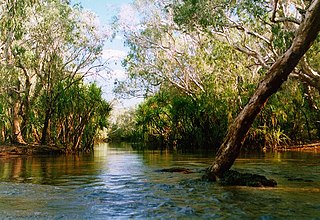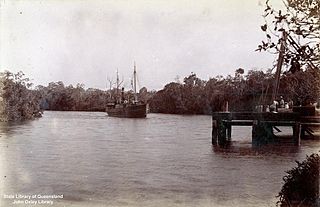
The Flinders River is the longest river in Queensland, Australia, at approximately 1,004 kilometres (624 mi). It was named in honour of the explorer Matthew Flinders. The catchment is sparsely populated and mostly undeveloped. The Flinders rises on the western slopes of the Great Dividing Range in North West Queensland and flows generally north-west through the Gulf Country, across a large, flat clay pan, before entering the Gulf of Carpentaria.

The Victoria River is a river in the Victoria Bonaparte bioregion of the Northern Territory, Australia.

Joseph Bonaparte Gulf is a large body of water off the coast of the Northern Territory and Western Australia and part of the Timor Sea. It was named after Joseph Bonaparte, brother of Napoleon and King of Naples (1806-1808) and then Spain (1808-1813) by French explorer and naturalist Nicolas Baudin in 1803. It is also often referred to in Australia as the "Bonaparte Gulf".

The purple-crowned fairywren is a species of bird in the Australasian wren family, Maluridae. It is the largest of the eleven species in the genus Malurus and is endemic to northern Australia. The species name is derived from the Latin word cǒrōna meaning "crown", owing to the distinctive purple circle of crown feathers sported by breeding males. Genetic evidence shows that the purple-crowned fairywren is most closely related to the superb fairywren and splendid fairywren. Purple-crowned fairywrens can be distinguished from other fairywrens in northern Australia by the presence of cheek patches and the deep blue colour of their perky tails.

The Mary River flows in the Northern Territory of Australia and is a site of the Mary River National Park.

The buff-sided robin is a small, diurnal, insectivorous, perching (passerine) bird in the family Petroicidae, a group commonly known as the Australo-Papuan or Australasian robins. It is also known as the buff-sided fly-robin, buff-sided shrike-robin and Isabellflankenschnäpper (German). The buff-sided robin is endemic to northern Australia, where it primarily occurs in riparian forests and monsoon vine thickets from the Kimberly region of Western Australia to the north-west Queensland Gulf of Carpentaria. The plumage of the adult birds is characterised by a dark hood and back with a prominent white stripe on the supercilium; a white throat, white wing and tail bars, and a striking buff to orange patch on the flank below the wings. Adult birds are not sexually dimorphic; however, males are generally larger and can be separated from females based on morphological measurements. Buff-sided robins predominantly take insects from the ground by sallying from an observational perch. Insect prey are also occasionally taken by hawking on the wing or by gleaning from the trunk or foliage of riparian vegetation.
The Calvert River is a river in the Northern Territory of Australia.

The Victoria Plains tropical savanna is a tropical and subtropical grasslands, savannas, and shrublands ecoregion in northwestern Australia.
Buckingham River is a river in the Northern Territory of Australia.
The Wickham River is an ephemeral river, located in the Victoria Bonaparte bioregion of the Northern Territory in Australia.
The Koolatong River is a river in the Northern Territory, Australia.
The Moyle River is a river in the Northern Territory, Australia.
The Goomadeer River is a river in the Northern Territory, Australia.

The Goyder River is a river in the Northern Territory, Australia.
The Walker River is a river in the Northern Territory, Australia.
The Robinson River is a river in Australia's Northern Territory.
The Nicholson River is a river located in the Northern Territory and the state of Queensland, Australia.
The Lynd River is a river located on the Cape York Peninsula in Far North Queensland, Australia.
The Kendall River is a river located in Far North Queensland, Australia.

The Proserpine River is a river in Whitsunday Region of Queensland, Australia.










